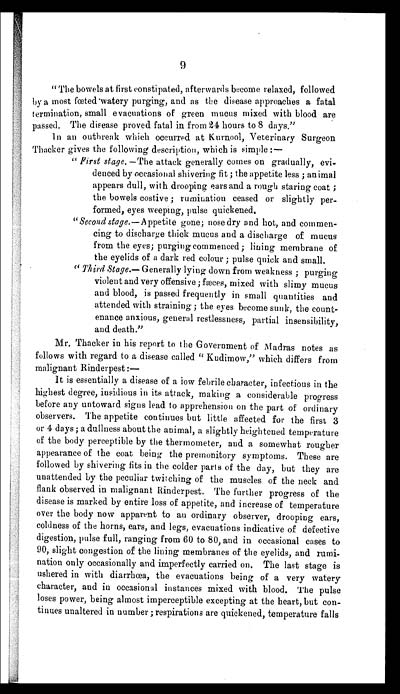Medicine - Veterinary > Civil Veterinary Departments > Civil Veterinary Department ledger series I-VI > Volume I - Rinderpest - cattle plague
(29) Page 9
Download files
Individual page:
Thumbnail gallery: Grid view | List view

13
All these facts lead us to the conclusion that it may be preserved
in the soil, and direct experiments have established the fact. Feser has
caused the disease by injecting the microbes found on the plants from
marshy pastures of the Alps, where the disease is rife. Gotti caused the
disease by injecting the water, in which had been washed earth from
San Arcangelo, where the disease had been prevalent, under the skin
of young oxen It is apparent, therefore, that the germs may be
preserved in the soil or on its surface, and this explains how it is that
animals which live in places where these germs exist, may ingest
them.
The virus offers great resistance to those chemical agents which we
designate bactericides; it is only sterilized, especially when dry, by
the most energetic of these. Solutions of potash, lime, sulphate of iron,
sodium chloride, arsenious acid, chloride of zinc, turpentine, sulphurous
acid, etc., are useless for purposes of disinfection. The agents which
may be recommended for this purpose are:— phenic acid in aqueous
solution 2-4%; salicylic acid 1-2%; nitrate of silver 1-2%; sulphate
of copper 1-5 ; perchloride of mercury 1-2 p. 1,000, etc.
Animals susceptible to the disease.—Charbon symptomatique is
nearly entirely confined in its attacks to the bovine species; it has only
exceptionally been witnessed in young sheep and solipeds. It is
transmissable by inoculation to oxen, sheep, goat, and guinea pig. The
carnivora, pig, rabbit and bird are refractory. The disease does not
appear to be transmitted to man.
The large and small ruminants are the most susceptible to the
disease, although, as has been stated, oxen do notexhibit the same
receptivity at all ages. The spontaneous malady is very rare in calves
before the age of six months, and it is rather a difficult matter to induce
it in suckling calves. Well marked and characteristic cases have,
however, been noted by veterinarians in young calves, which had already
been submitted to a vegetable diet. This quasi-immunity which young
calves enjoy appears to be due partly to heredity transmitted by an
already immune mother, and more particularly to the mode of alimentation
special to the age, as well as to the condition of the tissues and humors
during that age. Experimenting with animals of various breeds, we
have been able to inject six drops of fresh virus of a very active charac-
ter into the muscles of the young with impunity, whilst animals more
advanced in age succumbed in the proportion of 90% under similar con-
ditions. These inoculations, however, sometimes give rise to lameness
and elevation of temperature in certain of the calves; and by employ-
ing larger doses we cause death. Six or eight drops may destroy
calves of less than sixteen days of age ; it requires from ten to twenty
drops to kill calves aged from fifteen days to three months. The
Set display mode to: Large image | Zoom image | Transcription
Images and transcriptions on this page, including medium image downloads, may be used under the Creative Commons Attribution 4.0 International Licence unless otherwise stated. ![]()
| India Papers > Medicine - Veterinary > Civil Veterinary Departments > Civil Veterinary Department ledger series I-VI > Rinderpest - cattle plague > (29) Page 9 |
|---|
| Permanent URL | https://digital.nls.uk/75515851 |
|---|




